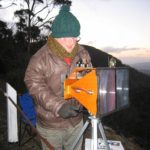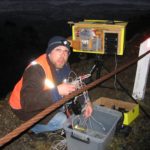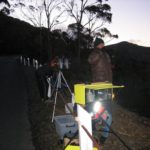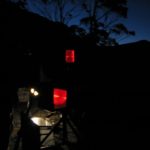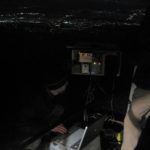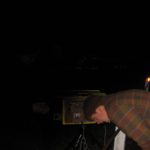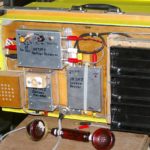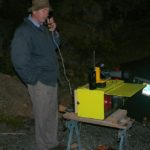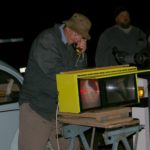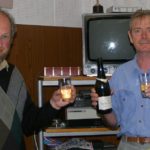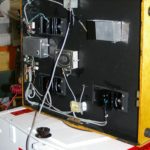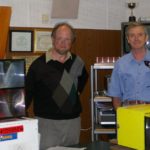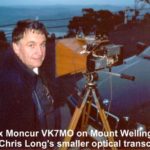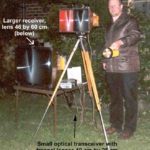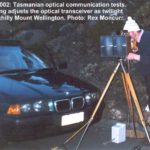VK7 OPTICAL COMMUNICATIONS EXPERIMENTATION
Optical LOS Record Broken in Utah – 3 October 2007 – 173miles
Read about it here.
Clint KA7OEI’s Modulated Light Website.
VK7 Digital Weak Signal LOS & NLOS Optical Experimentation
A group of VK7 Radio Amateurs have been experimenting using WSJT over optical transceiver links using line of sight and non line of sight paths. Below is a summary of the experiments. For more detail take a look at the reports list from most recent activity.
27 October 2009 – 288km Non-LOS Cloud-bounce Contact
Successful one way contact over a 288km path between Mt Horror (VK7JG & VK7KPG) – NE VK7 and Mt Liptrap (VK7MO) – Southern Gippsland VK3 over Bass Strait using the new Weak Signal Communicator created by David Smith VK3HZ.
See Report for more details
Third Quarter 2009 – Over the Horizon Optical Communications Article (4 of 4) by VK7TW & VK7MO
DUBUS Magazine (3/2009) for Amateur Radio on VHF and Above. Part 4 covers Receivers.
Second Quarter 2009 – Over the Horizon Optical Communications Article (3 of 4) by VK7MO & VK7TW
DUBUS Magazine (2/2009) for Amateur Radio on VHF and Above. Part 3 covers Transmitters.
First Quarter 2009 – Over the Horizon Optical Communications Article (2 of 4) by VK7ZAS & VK7MO
DUBUS Magazine (1/2009) for Amateur Radio on VHF and Above. Part 2 covers the Theory – Physics and Engineering.
24 November 2008 – 209km Non-LOS Cloud-bounce Contact
Success with a one way contact over the 209km path between Circular Head and Mt Horror.
See Report for more details
29 October 2008 – 209km Elevated Transmitter Test
A 209km path with an elevated transmitter to reduce the scatter angle was tried.
See Report for more details
22 October 2008 – 224km Non-LOS Cloud-bounce Tests
A path across the top of Tasmania was used to test a 224km path and signals were received in narrow bandwidth.
See Report for more details
11 October 2008 – 165km Non-LOS Cloud-bounce Contact
Extending the cloud-bounce contact distance to 165km with 10dB still to spare using the WSJT weak signal application.
See Report for more details
8 September 2008 – 118km Non-LOS Cloud-bounce Contact
Extending the cloud-bounce contact distance to 118km and comparison of the extinction of red and blue wavelengths over the 118km distance.
See Report for more details
Fourth Quarter 2008 – Over the Horizon Optical Communications Article (1 of 4) by VK7MO, VK7TW & VK7DY
DUBUS Magazine (4/2008) for Amateur Radio on VHF and Above. Part 1 covers the Overview and Practical Results.
22 December 2007 – Cloudbounce Tests to 66km
Extended cloud bounce testing pushing the distance to 66km using WSJT application.
See Report for more details
22 November 2007 – Extended Cloudbounce Test
Extended cloud bounce testing pushing the distance to 48km using WSJT application.
See Report for more details.
19 November 2007 – Preamp Signal to Noise Comparisons
Test range signal to noise comparisons of optical preamps built by VK7TW and VK7MO.
See Report for more details.
18 November 2007 – Field Cloud bounce Comparisons
Testing in the field of cloud bounce performance differences between VK7MO’s 35 photodiode array and VK7TW’s mirror dish single photodiode.
See Report for more details.
3 November 2007 – Multi-PhotoDiode Array
Testing using the 35 photodiode array over short (1.2km)and long (27km) path via cloud bounce.
See Report for more details.
15 September 2007 – Particle Scatter
Voice over optical particle scatter was achieved via a 1.2km path. Links to the recordings of these contacts are available in the report.
See Report for more details.
12 September 2007 – Cloud Bounce
Voice over optical cloud bounce was achieved via 1.2 & 5.3km paths. Links to the recordings of these contacts are available in the report.
See Report for more details.
4 September 2007
Testing undertaken to compare the performance of the VK7MJ and KA7OEI preamps. The result is at least a 12dB increase in system performance.
See Report for more details.
1 September 2007
Rex VK7MO and Justin VK7TW extend the non line of sight scatter from atmospheric particulate material experiments by varying the elevation angle of the transmitter and receiver to test the effect this has on signal strength.
See Report for more details.
22 August 2007
Rex, VK7MO and Justin VK7TW experiment with non line of sight scatter from particulate material in the atmosphere using Rex’s new transmitter.
See Report for more detail.
6 June 2007
REAST hosted an optical calibration night led by Mike VK7MJ. All current transmitters and receivers using Mike’s calibrated test gear.
See Report for more detail.
5 March 2007
Rex, VK7MO and Justin VK7TW have success with bouncing light signals off clouds using Rex’s 30x3w LED array transmitter.
See Report for more detail.
19 December 2006
Rex, VK7MO & Justin, VK7TW try a non line of sight contact with same city building to perform further azimuth and elevation tests.
See Report for more detail.
25 November 2006
Rex, VK7MO & Justin, VK7TW try a line of sight contact at a distance of over 30km with the following objectives:
- To attempt to break the VK 474 THz digital record;
- To attempt a voice contact;
- To check if a broad-beamwidth beacon, without a lens, could be copied over this path;
- To make a visual evaluation of Justin’s new “Big Box”;
- To compare the performance of Mike’s “Big” and “Green Boxes” on both TX and RX;
See Report for more detail.
22 November 2006
Rex, VK7MO & Ian, VK7ZIF try to establish if broad-beamwidth LED in its standard configuration, without a lens to test reception in a range of conditions with the following conclusions:
- A broad beamwidth 300 milli-watt output LED beacon gives 100% decodes at night time and is around 20 to 25 dB and above the level necessary to decode on WSJT at a distance of 6.8 km;
- Signal to noise ratios drop by about 35 to 40 dB in strong sunlight such that decoding is not possible;
See Report for more detail.
21 November 2006
Rex, VK7MO & Justin, VK7TW try a non line of sight contact using gum trees and performed the following experiments:
- To see if a QSO could be completed using light reflected from Gum Trees on Mt Knocklofty;
- To compare signal levels with previous tests using Empress Towers as the reflector;
- To vary alignment to establish the best signal level
See Report for more detail.
16 November 2006
Rex, VK7MO, Eric, VK7TAS & Justin, VK7TW repeat the non line of sight contact with same city building and performed the following experiments:
- Attempted QSO’s between VK7TAS and VK7MO and VK7TW and compare the different rigs and path losses;
- Compared signal levels with previous tests to gain an appreciation of propagation variability;
- Varied alignment to determine if signal strength might be improved;
See Report for more detail.
13 November 2006
Rex, VK7MO & Justin, VK7TW repeat the non line of sight contact with same city building and performed the following experiments:
- Compared the performance of Mike’s “Big Box” with his “Green Box”’
- Compared signal levels with previous tests and thus gain appreciation of the variability of path loss;
- Examined the use of attenuators (blocking part of the lens) as a means of controlling signal levels for system performance tests;
- Examined the affects of various WSJT settings on performance;
See Report for more detail.
4 November 2006:
Rex, VK7MO & Justin, VK7TW set inaugural VK7 digital over optical contact record with a non-line of sight contact scattering 474THz (red LED light) off city building using WSJT – JT65a mode. Report Sent: -25 dB and Report Received: -28 dB
Mt Wellington – Sorell (29.8km) Oct 2006
Optical Experimentation – New Frontiers Conquered!
Sunday 17th October 2006 saw a number of amateurs head off in opposite directions leaden with optical communications equipment and computers. The first group made up from Mike VK7MJ, Chris VK3AML/7, Chris VK7FCDW, Mike, Bruce VK7MBD & Essie and Justin VK7TW headed up Mount Wellington to just below the Organ Pipes pointing two optical transceivers in an easterly direction.
The second group made up from Ken VK7DY, Ian VK7ZIF, Mark VK7FMAC, Rex VK7MO and Danny VK7HDM and Danny’s father John headed to a hill behind Sorell with an optical transceiver. This was a distance of 29.8km through a variable hazy atmosphere during the night and simplex RF communication was maintained using 2m.
Duplex voice communications was established between each optical transceiver with Chris’ box proving to be slightly better at resolving the variable signal caused by the varying atmospherics on Mt Wellington.
SSTV was then tried over the link with Mt Wellington receiving two SSTV pictures perfectly from the Sorell end. We then tried to transmit from Mt Wellington to Sorell however, a few technical problems prevented a full picture being received however, the callsign VK7TW was visible on the received picture.
A quick re-patch saw the Mt Wellington group use Mike’s optical transmitter and Chris’ optical receiver for the WSJT testing over the optical link. Rex VK7MO and Justin VK7TW used JT65A mode to test the possibility of this weak signal mode over an optical link and a signal report was exchanged. Confirmation of the exchange and the acknowledgment of the report was made from analysis of the sound files the next day by Rex VK7MO.
It was a great learning experience for all involved and I think it has sparked some more interest in optical communications with a number of people now building transceivers to experiment.
See you all on 476THz soon!
(73, Justin, VK7TW)
Pictures of the event
(Pictures courtesy of Chris, VK7FCDW)
- Chris Long VK3AML/7 setting up
- Justin VK7TW trying to find “that” cable!
- We have lift off!
- That eerie luxeon glow!
- The SSTV and WSJT experiments
- Mike VK7MJ inspecting the SSTV results
Mt Wellington – Mt Barrow (167.7km) Feb 2005
MEDIA RELEASE
Amateur Optical Communications break the 100 mile barrier in Australia.
Between 1100 and 1200 GMT on Saturday the 19th of February 2005, two way full duplex voice communication was established at 475 THz [630nm] over a distance of 167.7 km [104 miles], between stations on the summits of Mount Wellington [1260m asl] near Hobart in Southern Tasmania, and South Barrow [1370m asl], near Launceston in Northern Tasmania. The tests were delayed by convective cap cloud and fog forming on the on the summit of mount Wellington at sunset. When the cloud cleared at 2140 local time, we had a beautiful crystal clear moonlit night over the centre of Tasmania, with light winds generating the occasional small drifting cloud puffs near Hobart.
Both transmitters used current modulated1W red Luxeon Lumileds operating at 200mA quiescent current at the focus of a 200mm diameter fresnel lens, and produced beam intensities of 300-700 W/steradian, and were clearly visible with the naked eye at 104 miles. The signals were detected by a BPW34 silicon diode at the focus of a 250 x 200 mm fresnel lens and a FET input amplifier. Signals going north were reported as 4/7 with some scintillation and slow fading by Joe VK7JG, Jason VK7ZJA and Chris Long on Mt Barrow. The signals received at Mt Wellington by Mike VK7MJ and Justin VK7TW on Mt Wellington were very noisy as a result of a 10db increase in the receiver noise, that turned out to be the result of an unstable audio amplifier, rather than RF blocking from the television transmitters, or moonlight interference as first thought. Reducing the receiver gain improved the readability to about 3/3 and a two-way duplex voice contact was completed.
Slow morse signals from a mechanically chopped optical transmitter using a 55W QI lamp and a 200mm lens were received at 5/8 on Mt Barrow.
The Hobart signals remained readable at Mt Barrow through light mist clouds drifting past Mt Wellington from about 1150 GMT, but the QSO was terminated at 12:00 GMT by heavy cloud re-forming above the Derwent Valley between Mt Wellington and Bridgewater.
This is certainly a record for Australian optical communications and possibly a world record for non-laser amateur communications.
73, Mike, VK7MJ
Pictures of the event
(Pictures courtesy of Justin, VK7TW)
- Mike Groth VK7MJ’s Optical Transceiver
- Mike, VK7MJ at the helm!
- VK7MJ operating the optical apparatus on Mount Wellington whilst Jamie, VK7KEG and harmonic Sam, (now VK7FBMX) look on.
- The toast and celebration of the event!
- Chris Long’s Optical Transceiver
- The proud optical experimenters!
Other References:
Previous Articles – Optical Communication
EXTRACTS FROM APC NEWS May 2003
Optical Communications
Australian experimenters are doing much good work in optical communications. The results achieved compare favourably with those of overseas experimenters.
A letter from Chris Long provides further details:
Dear Mr Editor,
I’m writing with regard to the rather dubious ‘optical communication record’ claimed in your bulletin of 16 April 2003. I’m not a licensed radio ham, but as far back as 1975 I operated a modulated light link over the two miles between myself and VK3ZGJ in Hawthorn, the system design of which I wrote in ‘Amateur Radio’, January 1979.
The transmitter consisted of a mercury vapour arc lamp, series modulated by four type 6080 triode regulator tubes wired in parallel. The receiver used a photomultiplier tube behind an iris aperture, with a five inch double-convex lens collecting the light.
This was a full duplex audio link, signal to noise averaged about 15 -20 dB, and it was used nightly by myself and VK3ZGJ between December 1975 and April 1976.
In 1989, with VK3AAR and VK3AML I tested a high intensity (2000 mCd) LED based optical link, on 660nM wavelength using 25 by 30 cm cheap ‘fresnel’ lenses for both transmit and receive. We switched to silicon PIN diodes for reception (type BPX65) and managed 60 dB sig/noise, full duplex over a similar two mile path. Same distance, but a much better sig/noise ratio!
At this point a video tape was made of a test by myself and VK3AML using the LED based system, and this video has been transmitted by Tony VK3AAZ on the Mount Dandenong ATV repeater on several occasions over the past twelve months.
It’s old (14 years), but it gives a good idea of the techniques used -and we’re still using these techniques with changes only in hardware and transmit power output.
We leapt in range when I set up an optical link between my former QTH in Torring Road, East Hawthorn, and the QTH of Peter Wolfenden VK3KAU in Spavin Drive, Sunbury. I might add that this was TWELVE YEARS AGO (!), the link being first used on 2nd April 1991 with 3KAU and 3IC at Sunbury and myself at East Hawthorn.
This was a full duplex audio (speech and music) link, bandwidth around 30 KHz, sig/noise was about 15dB with 100 Hz hum from streetlights being the main problem – AND THE RANGE WAS FORTY THREE AND A HALF (43.5) km – quite comparable to the British test. However the cumbersome nature of their needlessly expensive laser experiments – and providing only one-way CW in their case – does make the British work sound a little…. well … primitive!
Since then, work that Mike Groth VK7MJ, Rex Moncur VK7MO and I ave carried out has resulted in a two-way optical comms test in Tasmania last October using the new ‘Luxeon’ 60 Cd (1 watt) ultra high power LED’s on 630 nM wavelength (refer latest ‘Silicon Chip’) – and that was over a distance of about 30 km from Mount Wellington (near Hobart) to Birch’s Point near Woodbridge in Tasmania.
Rex 7MO was at my end, and Mike 7MJ was at the other, so this was in fact an ‘official’ amateur communication. All gear used fresnel lenses with rifle sights for alignment.
The results were phenomenal; full duplex audio both ways, 10 MHz (yes, ten MEGA-Hertz!) bandwidth available on the link, around 55 dB sig/noise but with fast flutter fade from atmospheric scintillation, at about a 2 to 5 Hz rate and about a 6 to 12 dB fade depth. Pulsed FM would overcome the problem, with a clipper/Schmitt on the photodiode at the receiver.
Optical DX range is chiefly limited by the diameter of the transmitting and receiving optics with through-the-atmosphere optical communication, not by the usage of coherent sources and the problems they encounter in transmission through the turbulent atmosphere, which will cause a coherent beam to de-cohere (with resultant noise) over a very short path.
I am now using an 18 inch by 36 inch fresnels – perhaps a little cumbersome but at least it’s a full duplex audio system, not CW, relatively noise free and of very broad bandwidth.
Perhaps we only claim records in ignorance of what others have achieved. Mike 7MJ and I claim no records – but we do think our gear, as it stands with 50 dB over 30 km 7MJ-7MO, could easily link 160 km or more given a suitable path.
Thanks again – I’m not a Brit basher, but this 49 km CW one-way stuff that was reported some time ago does seem rather poor….Been there, done that, and decades ago it was, too, with VK’s 3KAU, 3IC, 3AML, 7MJ and 7MO… as many will have seen on VK3RTV!
(Chris Long (unrepentant experimenter and SWL!) and Mike Groth VK7MJ via APCNews)

